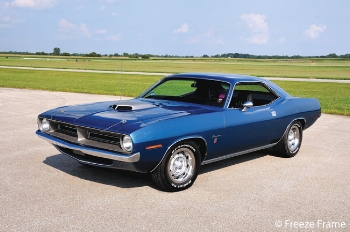The Plymouth Barracuda
/The Plymouth Barracuda was introduced on April 1, 1964 but it was no joke. It was a sporty derivative of the tried and true Valiant compact sedan. The Barracuda broke ranks with the vanilla Valiant sporting a sleek fastback roof, bucket seats, and an innovative fold-down rear seat that created a long flat cavernous cargo area. It might have been the coolest new car of 1964, had not 16 days later Ford introduced the Mustang.
Comparing the Barracuda to the Mustang was like seeing two movies about the same subject. But one is an art house film, the other a Hollywood blockbuster. You appreciate the Barracuda’s elegant shape as the eye lingers on its many fine details. With the Mustang, you are swept up in the spectacle of it all.
The sales charts, like the box office, reveal America’s preferences. Plymouth made a tidy profit selling 23,000 Barracudas in its abbreviated first year, and a further 65,000 in 1965. Ford sold nearly a million Mustangs it its first 18 months, giving birth to an American icon. Together the Mustang and Barracuda launched a brand new automotive category… and they weren’t called Fish Cars.
www.MustangSource.com
A redesign for the Barracuda came in 1967. Following the Mustang’s lead, the sporty Plymouth no longer bore such stark visual connection to the dull-as-dirt compact sedan on which it was based. It was now a unique line that included coupe, fastback and convertible version. The Barracuda’s humble beginnings where still evident to the sharp observer. That wasn’t necessarily a bad thing. With less mass and slightly smaller dimensions Barracuda was nimbler than the Mustang, which had gotten bulkier with its own update that year.
www.carinpicture.com
Nineteen sixty-seven also saw the debut of Chevrolet’s sporty Camaro. Mercury brought out the elegant Cougar that was based on the Mustang. Pontiac introduced its sexy Firebird. Even though the Barracuda was the first of the sporty compacts, it seemed to always be playing catchup.
The 3rd generation Barracuda of 1970 finally caught up. This writer would say it left Mustang and the others in the dust. All visual links to the humble Valiant were obliterated. There was not a wrong line in this car. The ’70 Barracuda was arguably the most refined and handsome iteration of Chrysler’s new aircraft inspired “fuselage” look.
www.OldCarsWeekly.com
Unlike some of its competitors in the pony car field, with tasteful application of graphics and accessories, even tarted up versions of the Barracuda were still gorgeous.
www.classiccarsphotedia.com
The trouble with perfection is that it is fleeting. Trouble for Barracuda’s looks came from Detroit’s requirement that each model year bring updates and “improvements.” Nineteen seventy-one brought a quadra-lamp faceplate, complete with a set of teeth in its grill that would do any predatory fish proud. But art it wasn’t.
The revised car seemed cartoonish compared to the sublime original. This, however, made it the perfect choice of wheels two decades later for the cartoonish namesake star in TV’s Nash Bridges. What is it about network television that seeks to put undercover detectives in the most over covercars imaginable?
It was fitting, given the unfortunate timing of its earlier ancestors, that just as the Barracuda was reaching its full potential in 1970, the market at which it was aimed turned to decline. When work began on this latest, greatest and unfortunately last Barracuda in 1968, combined Pony Car sales accounted for over 8% of the new car market. By its introduction 2 years later, the sector was grazing below 6%. By 1971, insurance rates on performance cars were soaring. Sales correspondingly cratered.
Midway through the 1974 season, and almost exactly 10 years after its introduction, the first “pony car” was dropped from Plymouth’s lineup. That announcement of the Barracuda’s demise could be pointed to as the beginning of the end for the storried brand.






